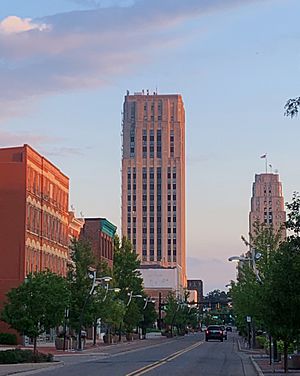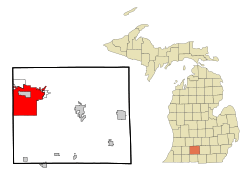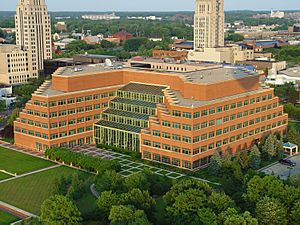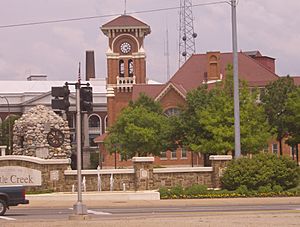Battle Creek, Michigan facts for kids
Quick facts for kids
Battle Creek, Michigan
|
|||
|---|---|---|---|

View of Downtown Battle Creek
|
|||
|
|||
| Nickname(s):
"Cereal City"
|
|||

Location of Battle Creek within Michigan
|
|||
| Country | United States | ||
| State | Michigan | ||
| County | Calhoun | ||
| Settled | 1831 | ||
| Incorporation as a Village 1840 | Incorporated as a city in 1859 | ||
| Founded by | Sands McCamly | ||
| Named for | Battle Creek River | ||
| Government | |||
| • Type | Council-Manager | ||
| Area | |||
| • Total | 43.74 sq mi (113.27 km2) | ||
| • Land | 42.59 sq mi (110.30 km2) | ||
| • Water | 1.15 sq mi (2.97 km2) | ||
| Elevation | 840 ft (256 m) | ||
| Population
(2020)
|
|||
| • Total | 52,721 | ||
| • Density | 1,237.96/sq mi (477.98/km2) | ||
| Demonym(s) | Battlecreekite | ||
| Time zone | UTC−5 (Eastern) | ||
| • Summer (DST) | UTC−4 (Eastern) | ||
| ZIP Codes |
49014–49018, 49037
|
||
| Area code | 269 | ||
| FIPS code | 26-05920 | ||
| GNIS feature ID | 0620755 | ||
| Website | www.battlecreekmi.gov | ||
Battle Creek is a city in Michigan, USA. It's located where the Kalamazoo and Battle Creek rivers meet. In 2020, about 52,731 people lived there. Battle Creek is often called "Cereal City" because it's where famous companies like WK Kellogg Co and Post Consumer Brands started.
Contents
- How Battle Creek Got Its Name
- History of Battle Creek
- Geography and Climate
- People of Battle Creek
- Economy and Jobs
- Education in Battle Creek
- Culture and Entertainment
- Sports in Battle Creek
- Places to Visit
- Getting Around Battle Creek
- Shopping Areas
- Famous People from Battle Creek
- Sister Cities
- Images for kids
- See also
How Battle Creek Got Its Name
One story says Battle Creek got its name from an event in March 1824. A group of government surveyors met two Potawatomi Native Americans. The Potawatomi people were hungry because their supplies from the U.S. Army were late. They tried to take food, and one surveyor shot and hurt one of them. After this, the surveyors went back to Detroit. Early settlers then called the nearby stream Battle Creek River, and the town got its name from that.
Another story says the local river, called Waupakisco by Native Americans, was named after a fight between different tribes long ago. However, some experts believe the native name doesn't actually mean "battle" or "blood".
History of Battle Creek
Around 1774, the Potawatomi and Ottawa Native American tribes had a village near what would become Battle Creek. The first European settlements in Battle Creek Township began around 1831, after the Potawatomi moved to a reservation. More settlers came to Michigan after the Erie Canal was finished in New York in 1824. Many chose to live on the Goguac prairie because it was good for farming.
A post office opened in Battle Creek in 1832. The first school was taught in a small log house around 1833 or 1834. The first sawmill was built in 1837. A brick factory started in 1840 and ran until 1903. The township was officially created in 1839.
A Stop on the Underground Railroad
Before the American Civil War, Battle Creek was an important stop on the Underground Railroad. This was a secret network that helped fugitive slaves escape to freedom in Michigan and Canada. Famous abolitionist Sojourner Truth chose Battle Creek as her home after she escaped slavery.
The Seventh-day Adventist Church
Battle Creek played a big part in the early history of the Seventh-day Adventist Church. In 1863, a church founding meeting was held here. The church's first hospital, college, and publishing office were also built in the city. When the hospital and publishing office burned down in 1902, the church decided to spread out, and most of its buildings moved to other places. The first Adventist church building (rebuilt in the 1920s) is still used today.
Health and Cereal City
Battle Creek was known for its focus on health in the late 1800s and early 1900s. The Battle Creek Sanitarium was started by the Seventh-day Adventist Church and Dr. John Harvey Kellogg. He was known for his health treatments.
W. K. Kellogg worked for his brother, John Harvey Kellogg, at the Sanitarium. One day, W.K. accidentally spilled liquid cornmeal on a hot device, which cooked it into flakes. He tasted them and added milk. Patients at the Sanitarium loved the flakes so much that W.K. decided to start his own company. He built a factory to make his "corn flakes".
Later, Dr. John Harvey Kellogg sued his brother over the corn flakes idea. But the U.S. Supreme Court decided in W.K. Kellogg's favor because his company was more popular.
Inspired by Kellogg's success, C. W. Post invented Grape-Nuts and started his own cereal company in Battle Creek. This is why Battle Creek is nicknamed "the Cereal City."
Geography and Climate
Battle Creek is a large city in Michigan by land area. About 60% of the city's land is developed. A large part of the city's land is undeveloped, including the Fort Custer Army National Guard Base/Industrial Park.
Climate
Battle Creek has a climate with warm summers and cold, snowy winters.
| Climate data for Battle Creek, Michigan (1991–2020 normals, extremes 1895–present) | |||||||||||||
|---|---|---|---|---|---|---|---|---|---|---|---|---|---|
| Month | Jan | Feb | Mar | Apr | May | Jun | Jul | Aug | Sep | Oct | Nov | Dec | Year |
| Record high °F (°C) | 68 (20) |
70 (21) |
84 (29) |
90 (32) |
95 (35) |
101 (38) |
104 (40) |
103 (39) |
99 (37) |
91 (33) |
80 (27) |
68 (20) |
104 (40) |
| Mean daily maximum °F (°C) | 32.4 (0.2) |
35.7 (2.1) |
46.7 (8.2) |
60.0 (15.6) |
71.5 (21.9) |
79.9 (26.6) |
83.1 (28.4) |
81.3 (27.4) |
74.4 (23.6) |
61.7 (16.5) |
48.2 (9.0) |
36.8 (2.7) |
59.3 (15.2) |
| Daily mean °F (°C) | 24.8 (−4.0) |
26.9 (−2.8) |
36.7 (2.6) |
48.4 (9.1) |
59.7 (15.4) |
68.3 (20.2) |
71.5 (21.9) |
69.9 (21.1) |
62.9 (17.2) |
51.7 (10.9) |
39.9 (4.4) |
29.7 (−1.3) |
49.2 (9.6) |
| Mean daily minimum °F (°C) | 17.2 (−8.2) |
18.1 (−7.7) |
26.6 (−3.0) |
36.9 (2.7) |
47.9 (8.8) |
56.8 (13.8) |
59.9 (15.5) |
58.4 (14.7) |
51.3 (10.7) |
41.7 (5.4) |
31.6 (−0.2) |
22.6 (−5.2) |
39.1 (3.9) |
| Record low °F (°C) | −20 (−29) |
−24 (−31) |
−11 (−24) |
5 (−15) |
22 (−6) |
30 (−1) |
42 (6) |
37 (3) |
25 (−4) |
16 (−9) |
−6 (−21) |
−18 (−28) |
−24 (−31) |
| Average precipitation inches (mm) | 2.09 (53) |
1.58 (40) |
1.90 (48) |
3.23 (82) |
3.95 (100) |
3.67 (93) |
3.38 (86) |
3.52 (89) |
3.07 (78) |
3.66 (93) |
2.55 (65) |
1.84 (47) |
34.44 (875) |
| Average snowfall inches (cm) | 18.1 (46) |
15.6 (40) |
6.0 (15) |
2.1 (5.3) |
0.0 (0.0) |
0.0 (0.0) |
0.0 (0.0) |
0.0 (0.0) |
0.0 (0.0) |
0.5 (1.3) |
5.9 (15) |
16.4 (42) |
64.6 (164) |
| Average precipitation days (≥ 0.01 in) | 14.0 | 10.8 | 9.7 | 12.4 | 13.0 | 11.1 | 9.3 | 10.2 | 9.9 | 12.9 | 10.8 | 13.5 | 137.6 |
| Average snowy days (≥ 0.1 in) | 12.8 | 10.3 | 5.0 | 1.9 | 0.0 | 0.0 | 0.0 | 0.0 | 0.0 | 0.3 | 5.9 | 10.6 | 45.2 |
| Source: NOAA | |||||||||||||
People of Battle Creek
| Historical population | |||
|---|---|---|---|
| Census | Pop. | %± | |
| 1840 | 993 | — | |
| 1850 | 1,064 | 7.2% | |
| 1860 | 3,509 | 229.8% | |
| 1870 | 5,838 | 66.4% | |
| 1880 | 7,063 | 21.0% | |
| 1890 | 13,197 | 86.8% | |
| 1900 | 18,563 | 40.7% | |
| 1910 | 25,267 | 36.1% | |
| 1920 | 36,164 | 43.1% | |
| 1930 | 45,573 | 26.0% | |
| 1940 | 43,453 | −4.7% | |
| 1950 | 48,666 | 12.0% | |
| 1960 | 44,169 | −9.2% | |
| 1970 | 38,931 | −11.9% | |
| 1980 | 35,724 | −8.2% | |
| 1990 | 53,540 | 49.9% | |
| 2000 | 53,364 | −0.3% | |
| 2010 | 52,347 | −1.9% | |
| 2020 | 52,721 | 0.7% | |
| U.S. Decennial Census | |||
In 1982, the city of Battle Creek grew when it joined with Battle Creek Township. This nearly doubled the city's population. The Kellogg's company even said they might move their headquarters if this merger didn't happen.
2020 Census Information
In 2020, Battle Creek had 52,731 residents. There were 20,690 households, with about 2.4 people per house. Most households (89%) had a computer, and 82.8% had internet access.
The city's population was 68.2% White, 17.3% African American, 0.6% Native American, and 3.7% Asian. About 8.1% of people were from two or more races. Hispanic or Latino people made up 7.9% of the population.
The average age in the city was 36.3 years. About 25.8% of residents were under 18, and 15.2% were 65 or older. More than half of the residents (51.5%) were female. About 6.6% of the people were born in other countries. Also, 10.8% of people aged 5 and up speak a language other than English at home.
For adults 25 and older, 89.9% had a high school degree, and 21.1% had a college degree or higher. The average household income in 2020 was $42,285. About 22.7% of the population lived in poverty.
Economy and Jobs

Battle Creek has many different employers. Here are some of the largest ones: As of October 2023[update], according to a Battle Creek Unlimited report, the twenty largest employers in the city are:
| Employer | Industry | Staff |
|---|---|---|
| Denso Manufacturing Michigan, Inc. | Auto parts | 2,500 |
| WK Kellogg Co | Foods | 2,000 |
| FireKeepers Casino Hotel | Casino | 1,730 |
| Veterans Administration Medical Center | Medical services | 1,670 |
| Hart–Dole–Inouye Federal Center | Government | 1,500 |
| Bronson Battle Creek | Medical services | 1,360 |
| Fort Custer Training Center | Government | 825 |
| Duncan Aviation, Inc. | Aircraft refurbishing | 761 |
| Kellogg Community College | Education | 709 |
| Michigan Air National Guard | Government | 650 |
| TRMI | Electronics | 617 |
| Calhoun County | Government | 614 |
| II Stanley Company, Inc. | Lights and equipment | 609 |
| Post Consumer Brands | Foods | 600 |
| City of Battle Creek | Government | 532 |
| Magna Cosma Castings | Auto parts | 450 |
| Battle Creek Public Schools | Education | 433 |
| Musashi Auto Parts, Inc. | Auto parts | 425 |
| Lakeview School District | Education | 395 |
| Adient | Auto parts | 334 |
Education in Battle Creek
Battle Creek has several colleges and universities, as well as public and private schools.
Colleges and Universities
- Kellogg Community College: A two-year college started in 1956.
- Western Michigan University's Battle Creek Branch: The Kendall Center.
- Western Michigan University's College of Aviation: Located at W.K. Kellogg Airport.
- Spring Arbor University Battle Creek Branch.
- Central Michigan University: Battle Creek Campus on the Air National Guard Base.
Public School Districts
- Battle Creek Public Schools
- Harper Creek Community Schools
- Lakeview School District
- Pennfield School District
High Schools
- Battle Creek Central High School
- Harper Creek High School
- Battle Creek Area Learning Center (also called Calhoun Community High School)
- Lakeview High School
- Michigan Youth Challenge Academy
- Pennfield Senior High School
Private High Schools
- Battle Creek Academy
- Bedford Bible Church School
- Calhoun Christian School
- St. Philip Catholic Central High School
Specialized Schools
- Battle Creek Area Mathematics and Science Center: A school focused on STEM (Science, Technology, Engineering, Math) education.
- Calhoun Area Career Center: Provides career and technical training for older high school students.
Japanese Language Education
The Battle Creek Japanese School holds classes at the Lakeview School District building. This school helps Japanese students living in Battle Creek keep up with their studies in Japanese.
Culture and Entertainment
Battle Creek offers various cultural activities, media, and events.
Local Media
- The Battle Creek Shopper: A local daily newspaper.
- Battle Creek Enquirer: The main local newspaper, owned by Gannett.
Radio Stations
Many FM and AM radio stations can be heard in Battle Creek, offering different types of music and talk shows.
Festivals
- The World's Longest Breakfast Table: A unique event where people gather for a giant breakfast.
- The Battle Creek Field of Flight Entertainment Festival: An exciting event with air shows and hot air balloons.
- International Festival of Lights: A celebration with beautiful light displays.
Music Scene
- The Music Center: Serves the South Central Michigan area.
- Battle Creek Symphony Orchestra: Based at the W.K. Kellogg Auditorium. It's Michigan's longest-running symphony orchestra.
- The Brass Band of Battle Creek: A group of 31 brass and percussion players from around the world.
- Leilapalooza - The Leila Arboretum Music Festival: A free summer music festival held at the Leila Arboretum.
Sports in Battle Creek
Battle Creek is a hub for sports, hosting many state championships and youth tournaments.
High School Championships
Battle Creek hosts annual state championships for high school wrestling, volleyball, baseball, and softball. Fans come from all over to support their teams.
Youth Baseball
Each year, Battle Creek hosts the Sandy Koufax 13S World Series for 13-year-old baseball players.
Local Sports Teams
- Battle Creek Battle Jacks: A college baseball team that plays in the Northwoods League. They won their first championship in 2011. Their home field is C.O. Brown Stadium.
| Club | Sport | League | Venue |
|---|---|---|---|
| Battle Creek Battle Jacks | Baseball | Summer Collegiate Baseball, Northwoods League | C. O. Brown Stadium |
Former Sports Teams
- The Michigan Battle Cats/Battle Creek Yankees/Southwest Michigan Devil Rays: A minor league baseball team that played from 1995 to 2006.
- The Battle Creek Crunch: An indoor football team that played one season in 2006.
- The Battle Creek Belles: A women's professional baseball team that played in the All-American Girls Professional Baseball League in 1951 and 1952.
- The Battle Creek Revolution: A low-level professional hockey team that played from 2008 to 2011.
- The Battle Creek Blaze: An adult football team that raises money to fight cancer.
- The Battle Creek Knights: A minor league basketball team that won a championship in 2005.
- The Battle Creek Rumble Bees: A professional hockey team that played one season in 2019–2020.
Places to Visit
Battle Creek has many interesting places to explore:
- Art Center of Battle Creek
- Bailey Park & C.O. Brown Stadium
- Battle Creek Sanitarium (now the Hart–Dole–Inouye Federal Center)
- Battle Creek Tabernacle (Seventh-day Adventist Church)
- Binder Park Zoo
- Fort Custer Recreation Area
- Historic Adventist Village
- Kimball House Museum
- Battle Creek Regional History Museum
- Kingman Museum and Planetarium
- Leila Arboretum
- Linear Park
- Willard Beach and Park
- Willard Library
Fort Custer Army National Guard Base
Camp Custer was founded in 1917 and has been a training ground for soldiers since World War I. Parts of the base were later used for the Battle Creek Veteran's Hospital, Fort Custer National Cemetery, Fort Custer Recreation Area, and Fort Custer Industrial Park. This industrial park has over 90 different companies.
The United States Government still owns the land, but the state of Michigan manages it. The base is mostly undeveloped, wooded land and covers a large part of Battle Creek. The industrial park part of the base in Battle Creek is about 4.69 square miles. The nearby W.K. Kellogg Airport is used by both civilians and the Air National Guard.
Getting Around Battle Creek
Battle Creek is located on Interstate 94 (I-94), which is a major highway between Detroit and Chicago.
Trains and Buses
The Battle Creek Amtrak Station serves Amtrak trains. It also has Greyhound and Indian Trails bus lines. Freight trains from the Canadian National Railway and Norfolk Southern Railway also serve the city.
Public Transportation
Battle Creek Transit provides bus services for people living in the Battle Creek area.
Major Highways
 I-94
I-94 BL I-94
BL I-94 I-194
I-194 M-37
M-37 M-66
M-66 M-89
M-89 M-96
M-96
Air Travel
Kalamazoo-Battle Creek International Airport serves Battle Creek. Locally, W. K. Kellogg Airport is used for general aviation (smaller planes). This airport is also home to Western Michigan University's College of Aviation and Duncan Aviation.
Shopping Areas
Battle Creek has several shopping malls and plazas:
- Lakeview Square Mall
- Minges Brook Mall
- Minges Creek Plaza
- Harper Village Mall
- Beckley Plaza
- Lakeview Plaza West
- Minges Shoppes
- Capital Centre
- McCamly Place
- Columbia Plaza
- Katie Plaza
- Battle Creek Plaza
Famous People from Battle Creek
- Frankie Ballard - Country music singer
- Lance Barber - Television actor
- Johnny Bristol - Motown singer, songwriter, and producer
- Betty Hutton - Film actress
- John Harvey Kellogg - Doctor and health food advocate
- Will Keith Kellogg - Cereal company founder
- John Kitzmiller - Film actor
- Tony McGee - National Football League player
- Dick Martin - Comedian and actor
- Jason Newsted - Bassist for the band Metallica
- Lisa Rainsberger - Boston/Chicago Marathon winner
- Mike Reilly - Former Major League Baseball umpire
- Bob Rush - Major League Baseball pitcher
- Rick Snyder - Former Governor of Michigan
- Sojourner Truth - Abolitionist and women's rights activist
- Rob Van Dam - Professional wrestler
- Junior Walker - Motown saxophonist and singer
- Tauren Wells - Christian pop singer
- Ellen G. White - Author and co-founder of the Seventh-day Adventist Church
Sister Cities
Battle Creek has special "sister city" relationships with two other cities:
Since 1981, Battle Creek and Takasaki have exchanged students and teachers every summer.
Images for kids
See also
 In Spanish: Battle Creek (Míchigan) para niños
In Spanish: Battle Creek (Míchigan) para niños







